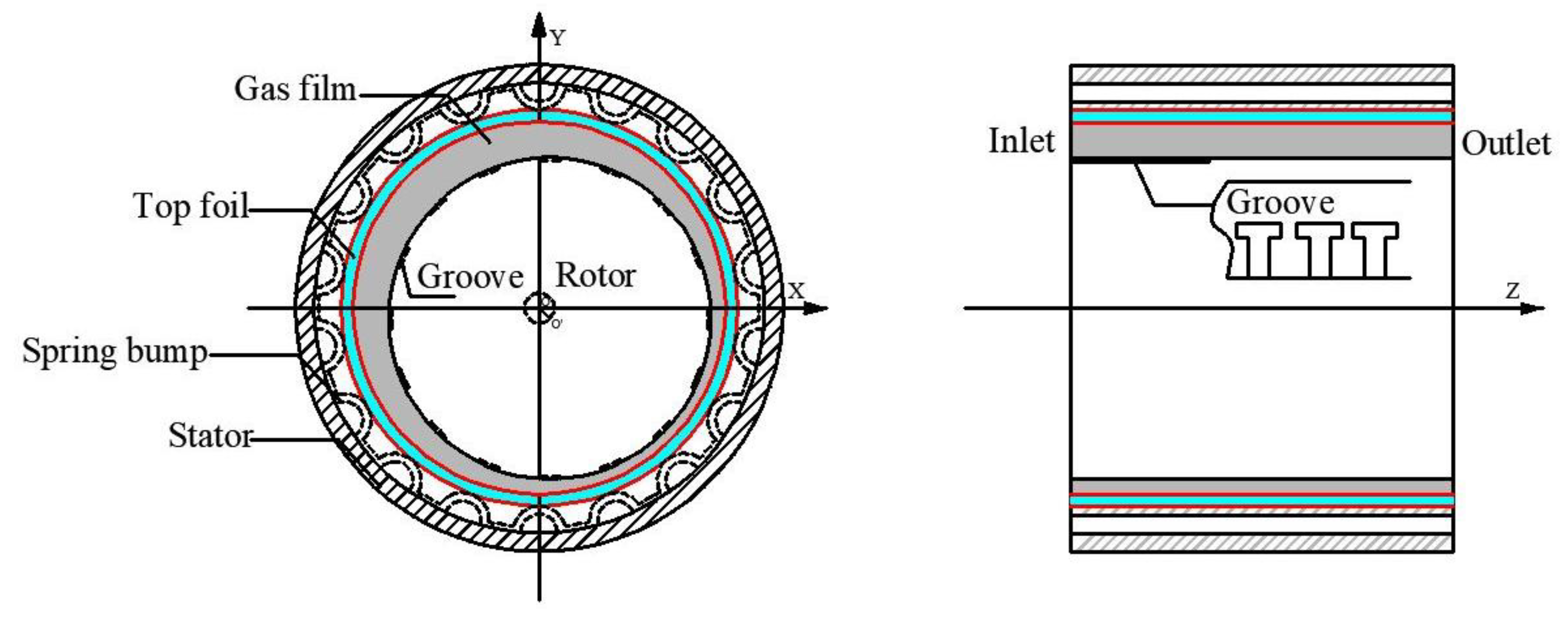Numerical Evaluation of Rotordynamic Coefficients for Compliant Foil Gas Seal
Abstract
:Featured Application
Abstract
1. Introduction
2. Methods
2.1. Governing Equation
2.2. Rotordynamic Coefficient Approach
3. Results
3.1. Numerical Analysis for Reliability
3.2. Rotordynamic Coefficients with Eccentricity Ratio
3.3. Rotordynamic Coefficients with Inlet Pressure
3.4. Rotordynamic Coefficients with Speed
4. Conclusions
- (1)
- For leakage and gas force evaluation of the compliant foil gas seal, the inlet pressure has the largest influence on the performance of the compliant foil gas seal. For the amplitude angle and friction, the impact of eccentricity ratio is greater than other factors. It is clear that speed is relatively small for the sealing system.
- (2)
- Regarding the direct stiffness coefficient and direct damping evaluation, the analysis results show the same tendency as the operation parameters change. The peak values of the direct coefficients increase with the growth of the eccentric ratio. However, the peak values of the direct coefficients decrease with the growth of pressure ratio and speed, which is harmful to the stability of the rotor system, so the initial operating values should be paid more attention when the parameters of the T-shaped groove need to be optimized further.
- (3)
- Regarding the cross-coupled stiffness and cross-coupled damping coefficient evaluation, the results show that they are almost symmetrical about the special value. Furthermore, they reach the peak point with the same value of the eccentric ratio, speed, and inlet pressure.
- (4)
- For the rotordynamic coefficient evaluation, it is necessary for plotting the prediction curve to obtain more parameters and coefficients in the future.
Author Contributions
Funding
Acknowledgments
Conflicts of Interest
References
- Sayma, A.I.; Breard, C.; Vahdati, M.; Imregun, M. Aeroelasticity Analysis of Air-riding seals for Aero-engine Applications. J. Tribol. 2002, 124, 607–616. [Google Scholar] [CrossRef]
- Xu, J.; Peng, X.D.; Bai, S.X.; Meng, X.K.; Li, J.Y. Experiment on wear behaviour of high pressure gas seal faces. Chin. J. Mech. Eng. 2014, 27, 1287–1293. [Google Scholar] [CrossRef]
- Wilbur, S.; Antonio, A. Numerical, Analytical, Experimental Study of Fluid Dynamic Forces in Seals; NASA Center for Aerospace Information: Hanover, MA, USA, 2004; Volume 2, pp. 1–140.
- Wilbur, S.; Antonio, A. Numerical, Analytical, Experimental Study of Fluid Dynamic Forces in Seals Interim; Report No. 1; Lewis Research Center of American: Cleveland, OH, USA, 1992. [Google Scholar]
- Mohsen, S.; Hooshang, H. On the Fluid Flow and Thermal Analysis of a Compliant Surface Foil Bearing and Seal. Tribol. Trans. 2000, 43, 318–324. [Google Scholar]
- Hendricks, R.C.; Steinetz, B.M.; Athavale, M.M.; Przekwas, A.J.; Braun, M.J.; Dozozo, F.K.; Kudriavtsev, V.V.; Mullen, R.L.; Von Pragenau, G.L. Interactive development of seals, bearings, and secondary flow systems with the power stream. Int. J. Rotating Mach. 1995, 1, 153–185. [Google Scholar] [CrossRef] [Green Version]
- Bruce, M.S.; Robert, C.H. Engine Seal Technology Requirements to Meet NASA’s Subsonic Technology Program Goals. J. Propuls. Power 1996, 12, 786–793. [Google Scholar]
- Liu, Y.C. Behavior of Gas Film Face Seal. Ph.D. Thesis, Beijing University of Aeronautics and Astronautics, Beijing, China, 1999. [Google Scholar]
- Hirs, G. A bulk-flow theory for turbulence in lubricant films. ASME J. Lubr. Technol. 1973, 105, 137–146. [Google Scholar] [CrossRef]
- Nordmann, R.; Dietzen, F. Finite Difference Analysis of Rotordynamic Seal Coefficients for an Eccentric Ratios Shaft Position; N89-22906; Department of Mechanical Engineering University of Kaiserslautern: Kaiserslautern, Germany, 1989. [Google Scholar]
- Ha, T.W. Prediction of combination-type-staggered labyrinth seal leakage using CFD. J. KSTLE 2006, 22, 66–72. [Google Scholar]
- Ha, T.W. Prediction of non-contact-type seal leakage using CFD. J. Fluid Mach. 2006, 9, 14–21. [Google Scholar]
- Su, Z.H. Numerical Simulation and Performance Analysis of Cylinder Gas Film Seal. Master’s Thesis, Kunming University of Science and Technology, Kunming, China, 2016. [Google Scholar]
- Ma, G.; Xi, P. Analysis of quasi-dynamic characteristics of compliant floating ring gas cylinder seal. J. Aerosp. Power 2010, 25, 1190–1196. [Google Scholar]
- Ma, G.; Xu, G.Z.; Shen, X.M. Design and Analysis for Spiral Grooved Cylindrical Gas Seal Structural Parameter. Lubr. Eng. 2007, 32, 127–130. [Google Scholar]
- Lu, J.J. Study on Dynamic Lubrication Characteristics of a New Floating Cylindrical Groove Gas Film Seal. Ph.D. Thesis, Lanzhou University of Technology, Lanzhou, China, 2018. [Google Scholar]
- Salehi, M.; Heshmat, H. Performance of a Complaint Foil Seals in a Small Gas Turbine Engine Simulator Employing A Hybrid Foil/Ball Bearing Support System. Tribol. Trans. 2001, 44, 458–464. [Google Scholar] [CrossRef]
- Tae, W.H.; Bok, S.C. Numerical prediction of rotordynamic coefficients for an annular-type plain-gas seal using 3D CFD analysis. J. Mech. Sci. Technol. 2014, 28, 505–511. [Google Scholar]
- Noel, B.; Bernard, T.; Jean, F. Influence of Fluid Flow Regime on Performances of Non-Contacting Liquid Face Seals. J. Tribol. 2002, 124, 515–523. [Google Scholar]
- Shen, X.M.; Liu, Y.C.; Ma, G. Tribology for Aero-Gas Turbine Engines; Beijing University of Aeronautics; Astronautics Press: Beijing, China, 2008; pp. 23–52. [Google Scholar]
- George, B.D.; Fred, W.O. Analytical Derivation and Experimental Evaluation of Short-Bearing Approximation for Full Journal Bearings; Report 1157; Cornell University: Ithaca, NY, USA, 1953. [Google Scholar]
- Childs, D.W. Finite-Length Solutions for Rotordynamic Coefficients of Turbulent Annular Seals. J. Technol. 1982, 105, 82–142. [Google Scholar] [CrossRef]








© 2020 by the authors. Licensee MDPI, Basel, Switzerland. This article is an open access article distributed under the terms and conditions of the Creative Commons Attribution (CC BY) license (http://creativecommons.org/licenses/by/4.0/).
Share and Cite
Wang, X.; Liu, M.; Kao-Walter, S.; Hu, X. Numerical Evaluation of Rotordynamic Coefficients for Compliant Foil Gas Seal. Appl. Sci. 2020, 10, 3828. https://doi.org/10.3390/app10113828
Wang X, Liu M, Kao-Walter S, Hu X. Numerical Evaluation of Rotordynamic Coefficients for Compliant Foil Gas Seal. Applied Sciences. 2020; 10(11):3828. https://doi.org/10.3390/app10113828
Chicago/Turabian StyleWang, Xueliang, Meihong Liu, Sharon Kao-Walter, and Xiangping Hu. 2020. "Numerical Evaluation of Rotordynamic Coefficients for Compliant Foil Gas Seal" Applied Sciences 10, no. 11: 3828. https://doi.org/10.3390/app10113828





